Home to a Wealthy Family, Famous Judge, Latin-School Founder and Others: 44 Monroe Place
Located on a quiet Brooklyn Heights street, 44 Monroe Place has been home to a number of the neighborhood’s social movers and shakers. An in-depth look at the families who lived in this elegant row house provides a fascinating glimpse into the evolution of the Brooklyn itself.

By Suzanne Spellen (aka Montrose Morris)
Located on a quiet Brooklyn Heights street, 44 Monroe Place has been home to a number of the neighborhood’s social movers and shakers. From the founder of a successful paint company to gentlemen boarders, debutantes, and a partner in the borough’s most famous department store, the inhabitants of this elegant-looking brick house provide us with a fascinating glimpse into the evolution of Brooklyn itself.
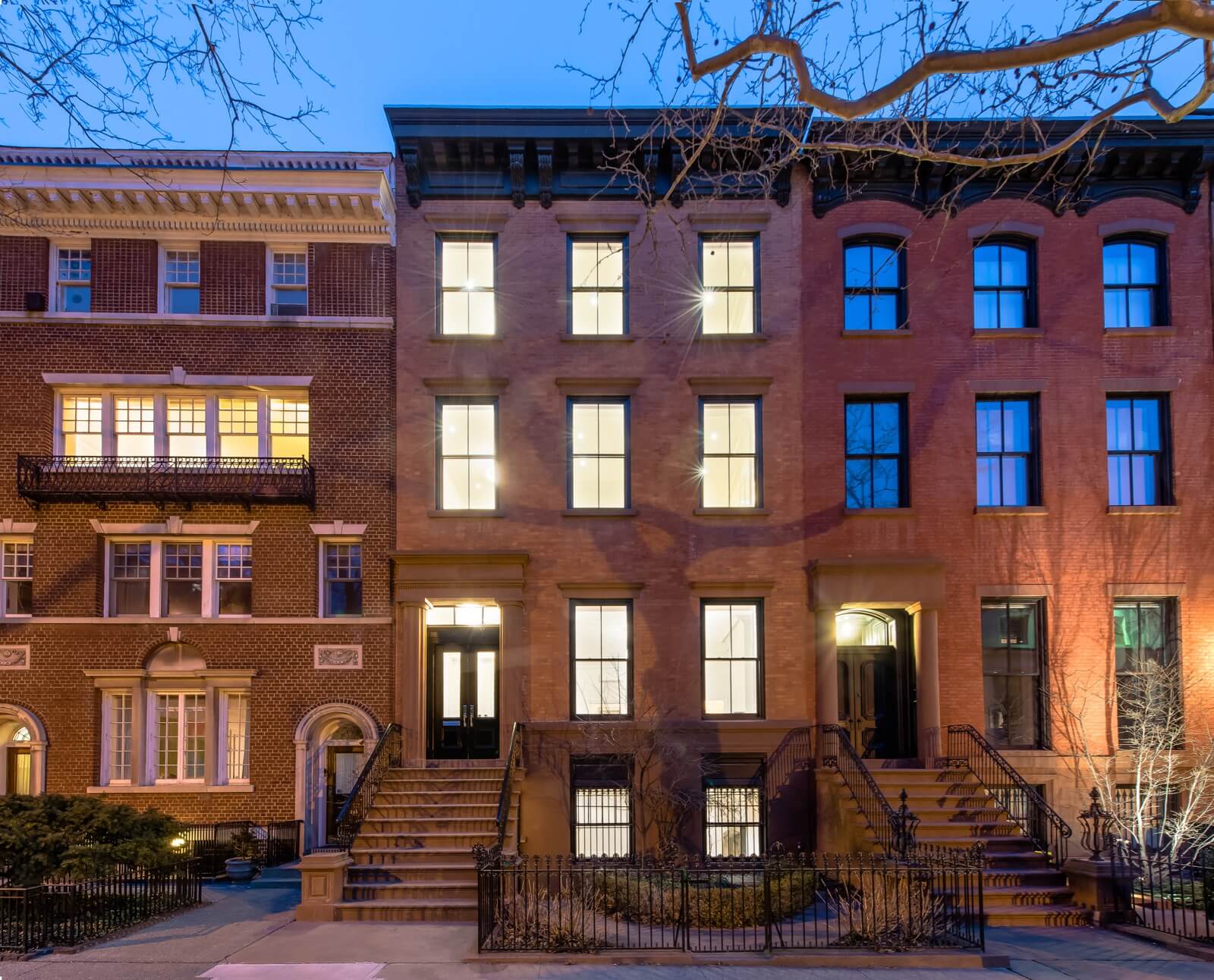
We hope you’ll sit down and take a few minutes to delve into the substantial history of this townhouse, but if you only have a moment, here’s a brief synopsis: Built in 1835, 44 Monroe Place was first occupied by a wealthy family in the paint business. The family was rocked by misfortune in 1887 when a tragedy took place at the company office on Front Street. In the early 1900s, new families moved into the home, including the founder of the Brooklyn Latin School for Boys, a famous Brooklyn judge, and others.

Now the property, on a 25-by-122-foot-deep lot, is on the market for $9.25 million. For more information or to arrange a private showing, please contact Associate Real Estate Broker Paul Murphy of Corcoran.
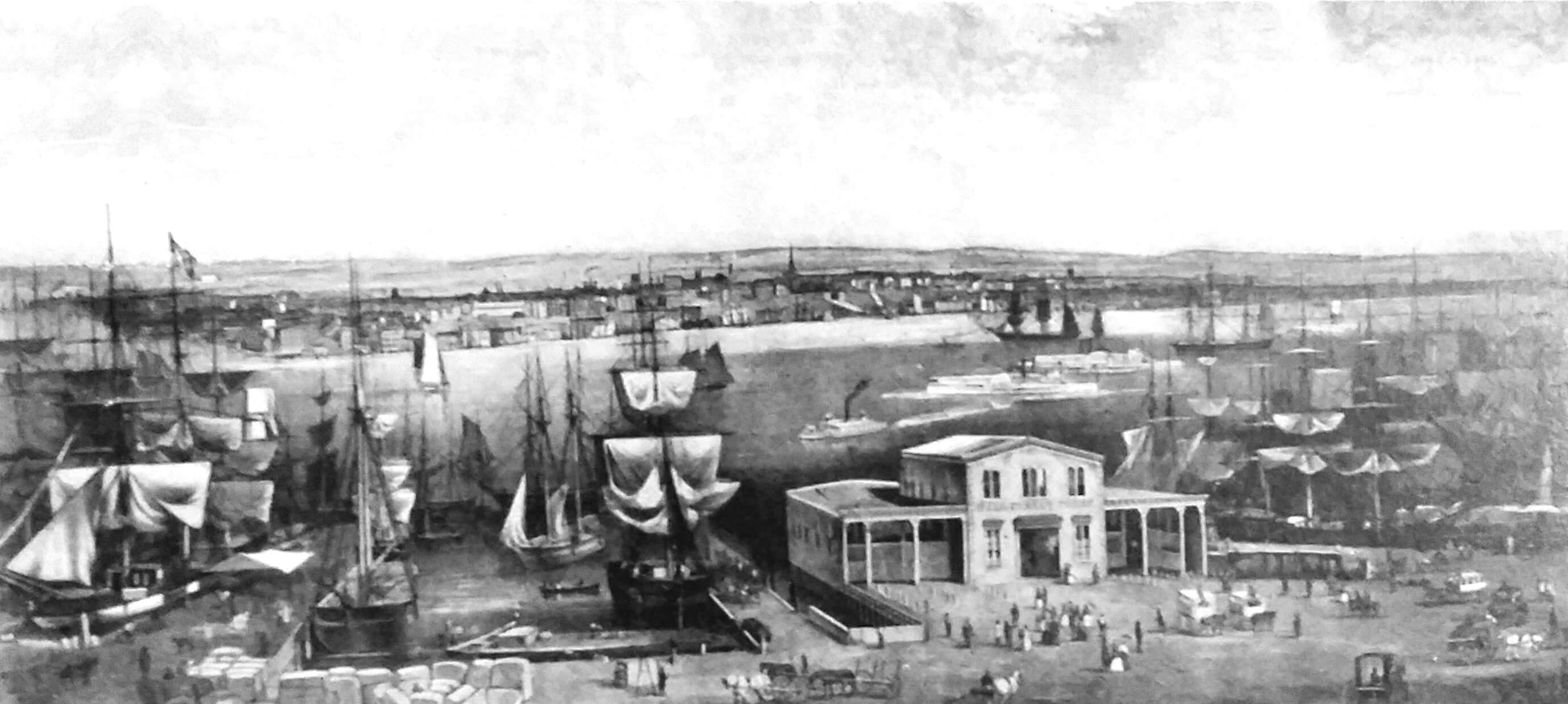
Brooklyn’s Early Development
The Dutch purchased the area known today as Brooklyn Heights from the Canarsie people in 1636. For over 150 years, it remained farmland and orchards, with a small settlement located at the shoreline and the beginning of ferry service to Manhattan.
After the Revolutionary War, the land belonged to gentlemen farmers with names like Hicks, Remsen, Livingston and Middagh. In 1802, a merchant prince named Hezekiah Beers Pierrepont purchased the old Livingston estate, and hired surveyors to lay out a street grid for residential development.
He thoughtfully named the streets after the old landowners and new neighbors like the Clintons, Montagues and Clarks — and himself, of course. Two of the neighborhood’s streets are named after Pierrepont.
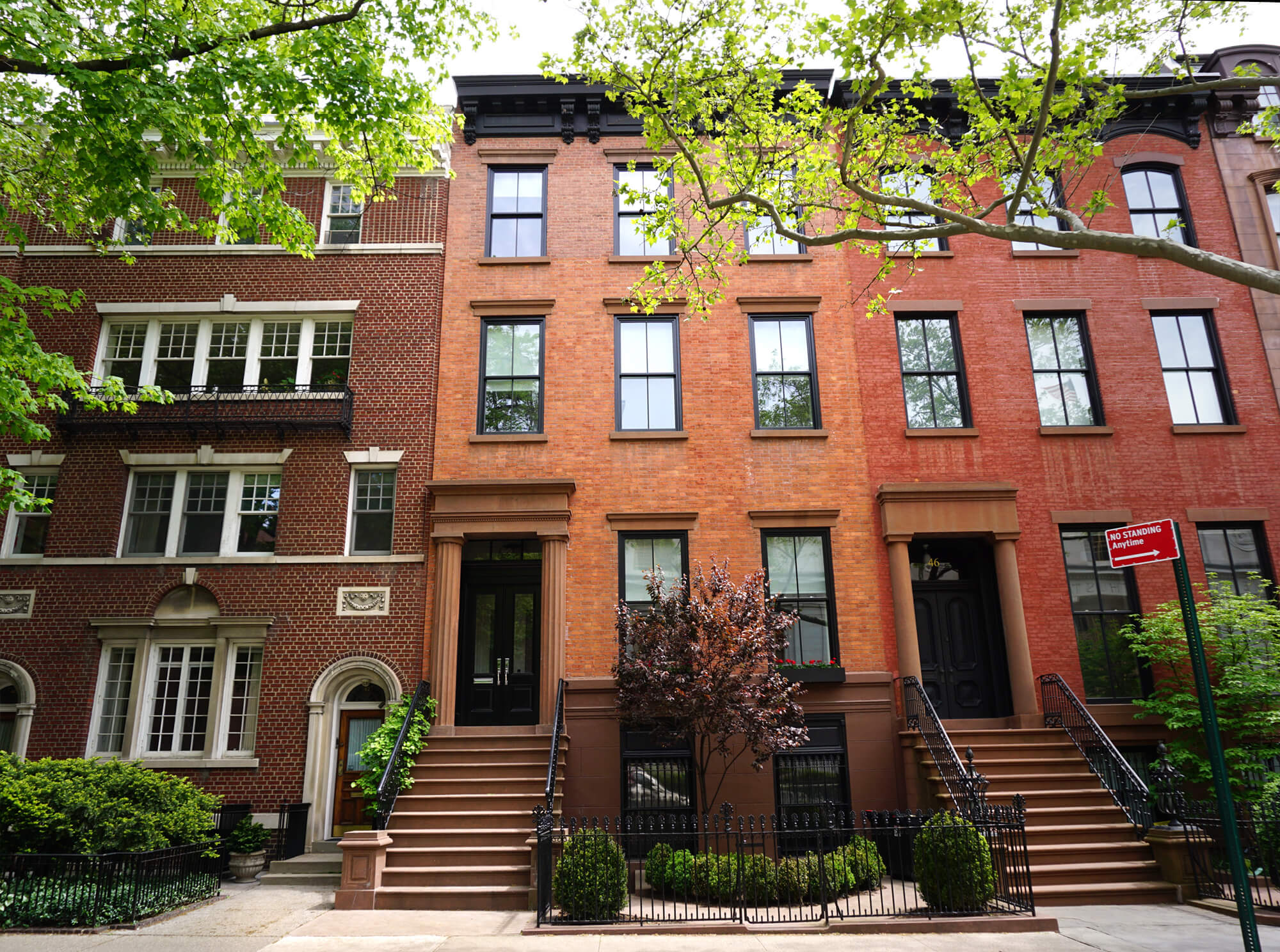
As Brooklyn Heights grew, the street grid was expanded outwards away from the harbor. Monroe Place was laid out in the early 1830s, named for President James Monroe, who died in 1831.
This short street has the distinction of being Brooklyn Heights’ widest block, and is the highest point on the Heights. With the exception of tiny College Place, it’s the only street with the odd numbers on the west and the even numbers on the east side of the street. It’s also the only street that retains the original numbering system, which was abandoned everywhere else in the Heights in 1871.
44 Monroe Place was built in 1835, along with its neighbor, number 46. They are both 25-foot-wide Greek Revival-style brick row houses, with a simple Doric-style doorway. The elegantly austere houses are brick, laid in Flemish bond, with brownstone trim.
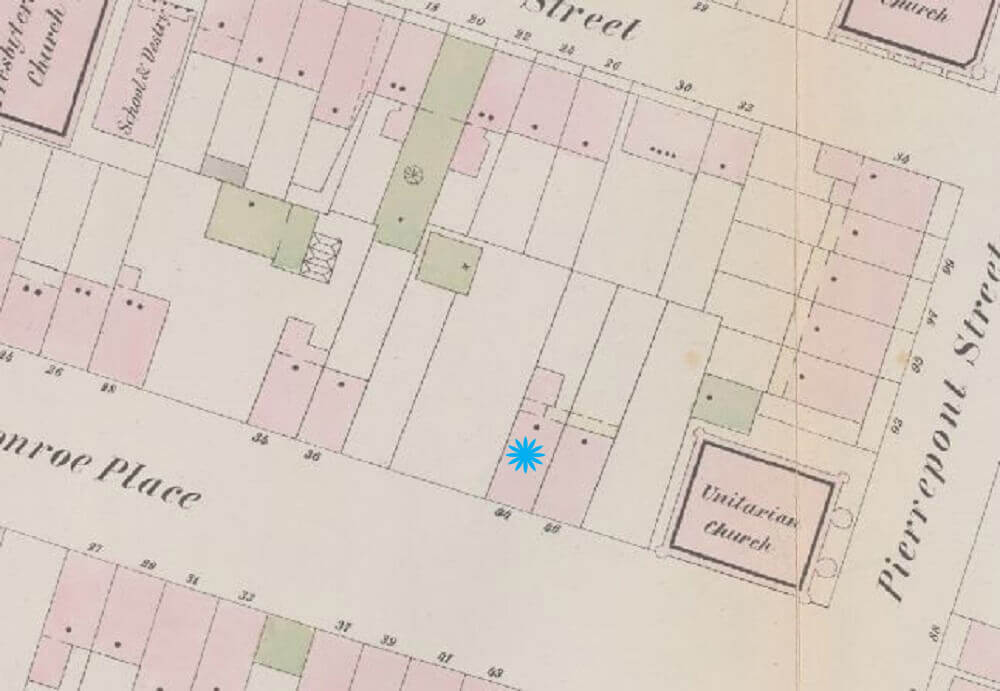
Both houses have wide steps with their original wrought iron railings. Both houses once had identical wrought iron basket urns capped with pineapples which stood on brownstone pedestals. The urns at 46 are the last remaining specimens in the Heights. They were once a common sight in the Heights.
The lots on this side of the block have irregular shapes and are exceptionally long. The reason for this is that Love Lane, the service street which now terminates at Henry Street, was originally laid out to reach Fulton Street, now Cadman Plaza West. This idea was abandoned early on, and the extra land for the street was incorporated into the surrounding properties.
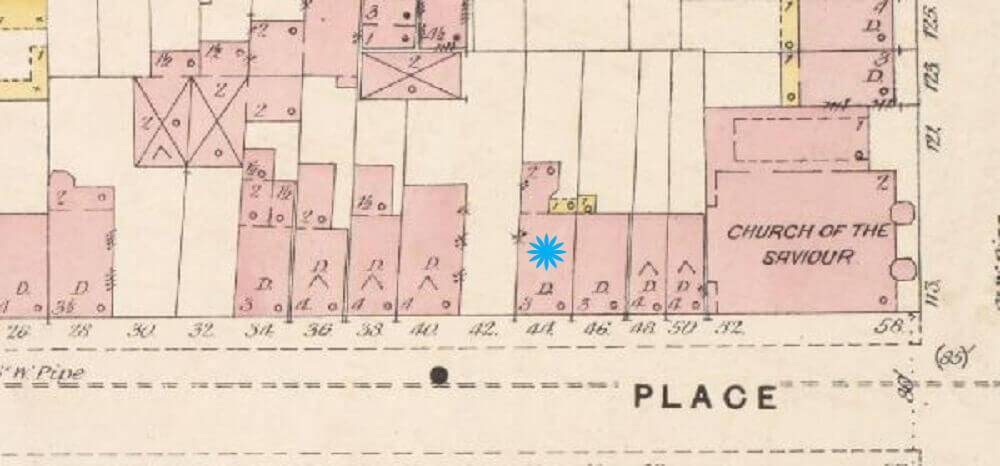
The lot next door, 42 Monroe Place, was apparently never developed. It remained empty in all of the 19th century maps of the area. It wasn’t built on until 1913, when 40 and 42 Monroe were developed as double duplex houses in a modern, neo-Georgian style.
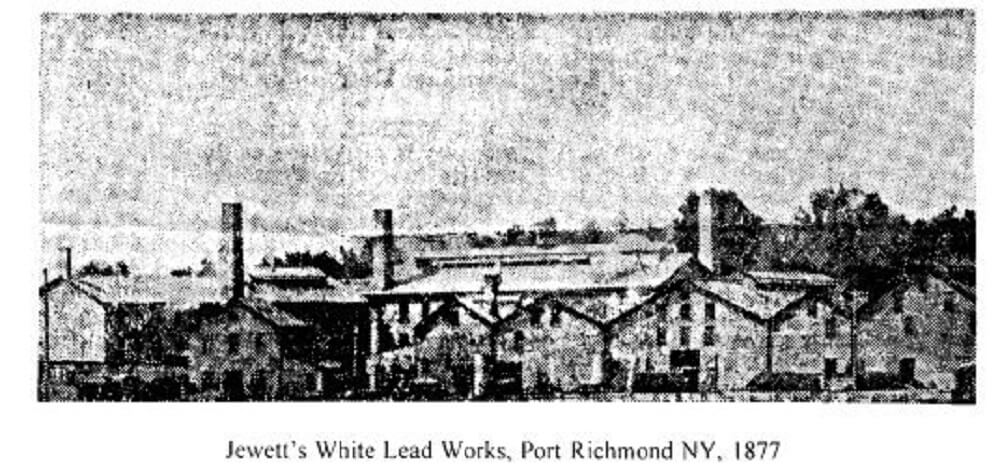
The First Owners of 44 Monroe Place – The Jewett Family
Like many of the early homes in Brooklyn Heights, these houses were built by experienced but anonymous builders. There is no architect or builder of record. Many houses of this period were built from popular plan books and the builder’s own experience and expertise. The twin homes were probably built as speculative houses.
According to family legend, 44 Monroe Place was purchased by John Jewett as a present to his wife in 1835. Jewett began his business life as a dry goods merchant in Manhattan. He is recorded as having his business at 2 Maiden Lane in Lower Manhattan. He and his family lived over the store. At the time, in the early 1820s, Maiden Lane was the center of Manhattan’s shopping district.
In 1827, as the business grew, the Jewett family decided to move to Brooklyn. They took up residence at 79 Willow Street, near Pineapple. Seven years later, when the Monroe Place house was completed, John Jewett bought it for his wife Lucy.
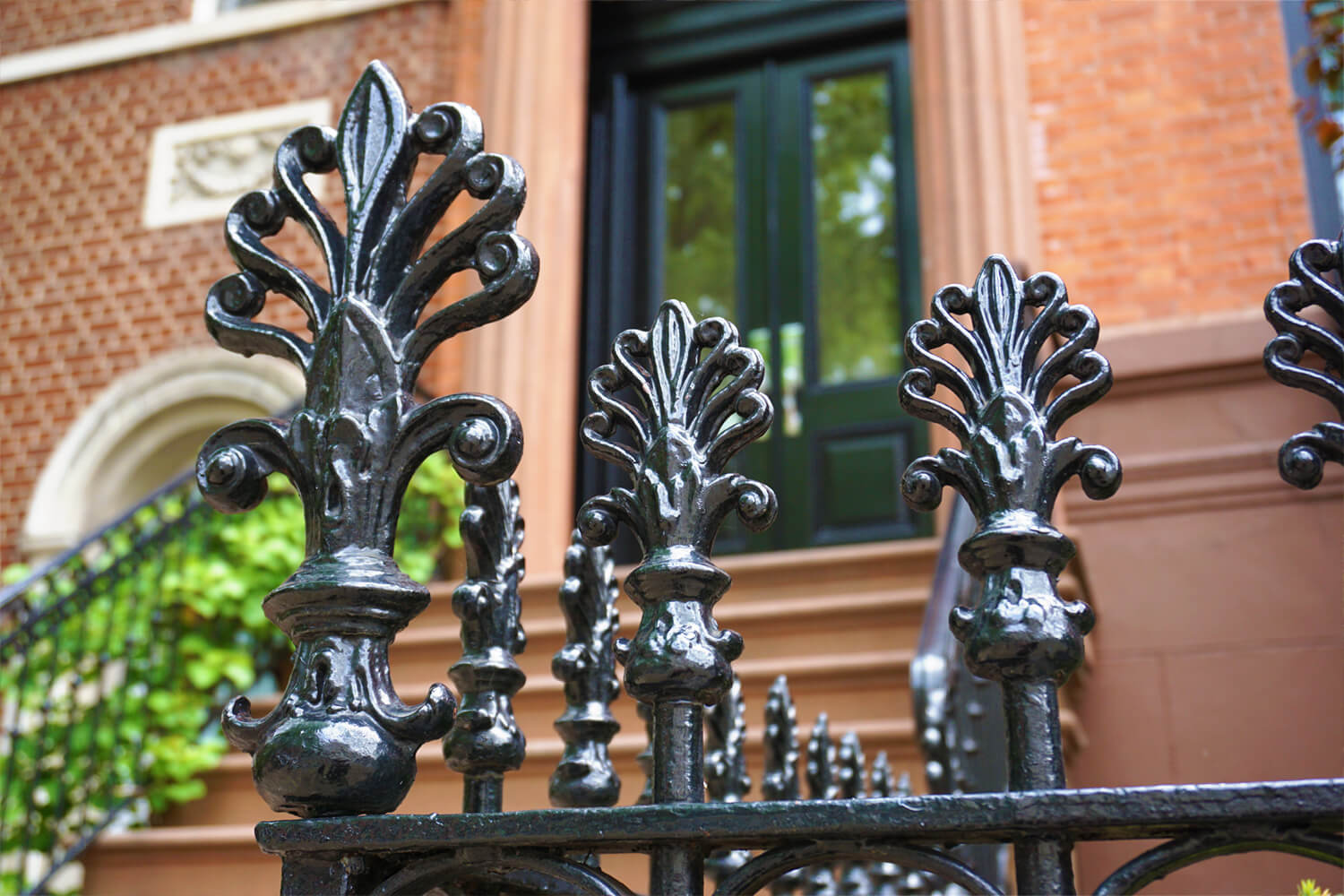
John Jewett expanded his business in 1842 by establishing the Jewett White Lead Works at Port Richmond, on Staten Island. The company later changed its name to John Jewett & Sons, after sons John Junior, George and Charles joined the business. Their offices, sales and shipping quarters moved to a large warehouse at 182 Front Street. Ads from the 1840s show them as manufacturers and sellers of white lead and linseed oil, and purveyors of oilcloths and paint products.
White lead was the powdered lead salt used in the 19th century as a vital ingredient in paint. For many years, it was the only white oil paint available to fine artists, as well as for commercial use. The powder was manufactured through a rather simple chemical reaction and then mixed with linseed oil to make paint.
Lead has been known since ancient times to cause insanity when absorbed in sufficient amounts, and this fact may have something to do with the tragedy that later took place.
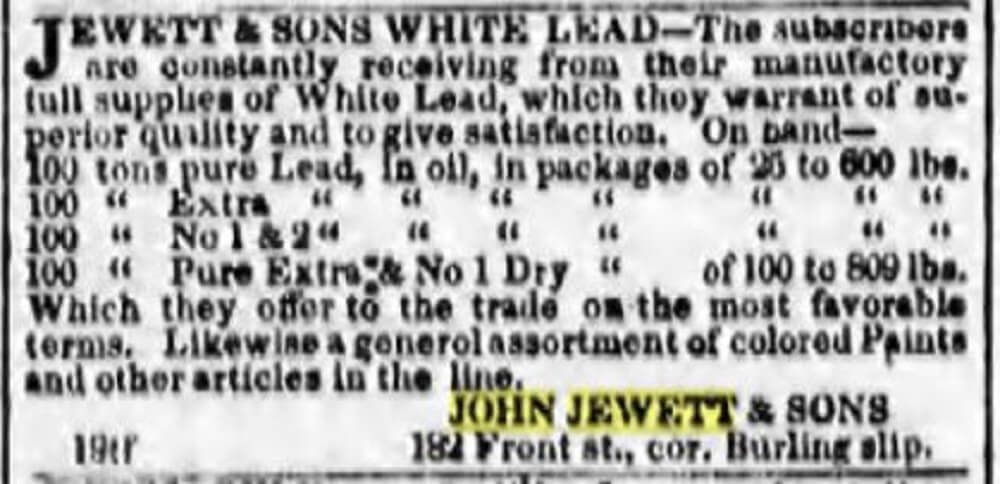
John and Lucy Jewett had 11 children, all of them born before they moved to 44 Monroe. Three of the children — Charles R., Frederick and Emily — died in infancy. The remaining eight consisted of sons John Junior, James, George, William and Charles Henry, and sisters Eliza, Sarah and Lucy. Lucy married merchant Benjamin F. Seaver here at the house in 1843.
This was the Jewett home for a long time. Lucy Jewett died in 1859. John remarried a few years later, to Lucy’s half-sister Sarah Stone. She was 67 when they married; he was 73. John Jewett retired and left the running of the business to his sons, and moved back to Orange, N.J., where the family had deep roots. He died there in December of 1867.
But the story of the Jewetts and 44 Monroe Place only gets more interesting.
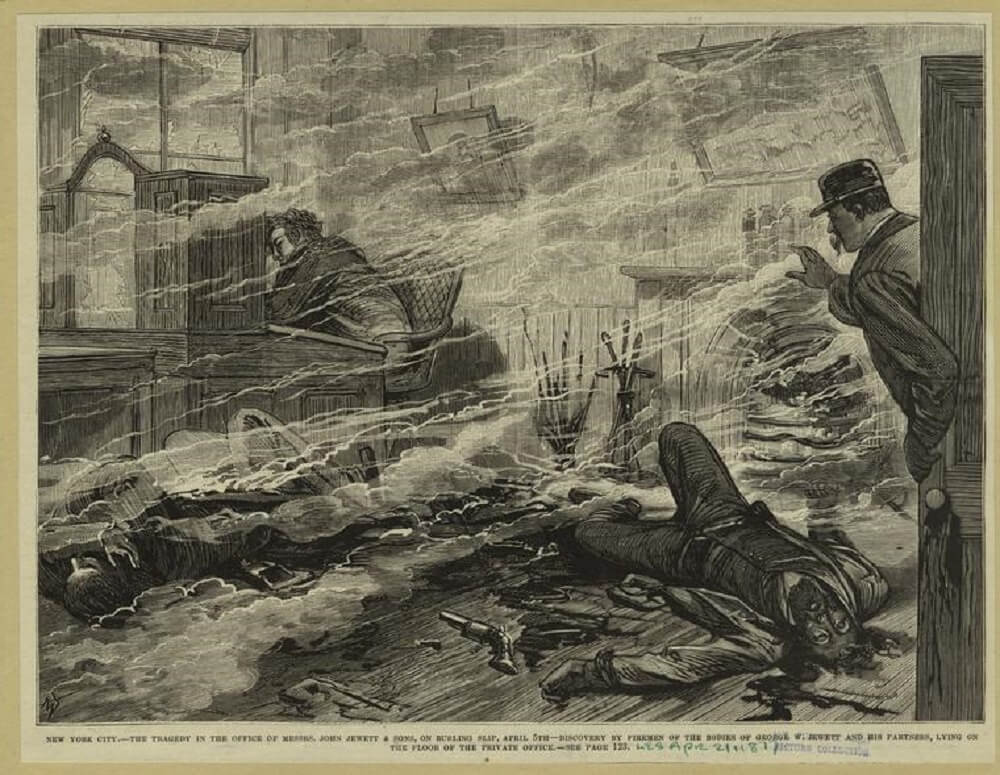
The Jewett Company Explosion and Murder Mystery
Fortunately for John and Lucy Jewett, they did not live to see the tragedy that befell their son and nephew. In early April of 1877, an explosion rocked the Front Street headquarters of the Jewett company. When the police got there, they found George Jewett dead on the floor. Orville Jewett, his nephew, son of John Jr., was gravely wounded, and business partner Joseph A. Dean was also seriously wounded.
They were all victims of a small explosion. Soon after arriving, another small explosion occurred, this one more like a gunshot, and Orville Jewett was now dead. From later testimony and evidence, it was apparent that Orville had exploded a grenade, killing his uncle, but only wounding himself and Dean. He then took advantage of the confusion to shoot himself before he could be taken to the hospital.
No one ever found out why Orville did it, but he was declared insane at the time. The police found a Bowie knife and a revolver on his body. His workers told investigators that lately, Orville had been arming himself. He had been a distinguished veteran during the Civil War, and had commendations for bravery in more than one battle. He went into the family business after the war, and seemed happy. He left a distraught wife.
George Jewett had been the senior partner in his father’s firm. He lived on Staten Island in a fine home, with his wife and two daughters, and was well regarded in the community. He supported many charitable causes, and was very active in civic affairs. His was a great loss to the community. The company continued in business until 1898, with the youngest son Charles taking over.
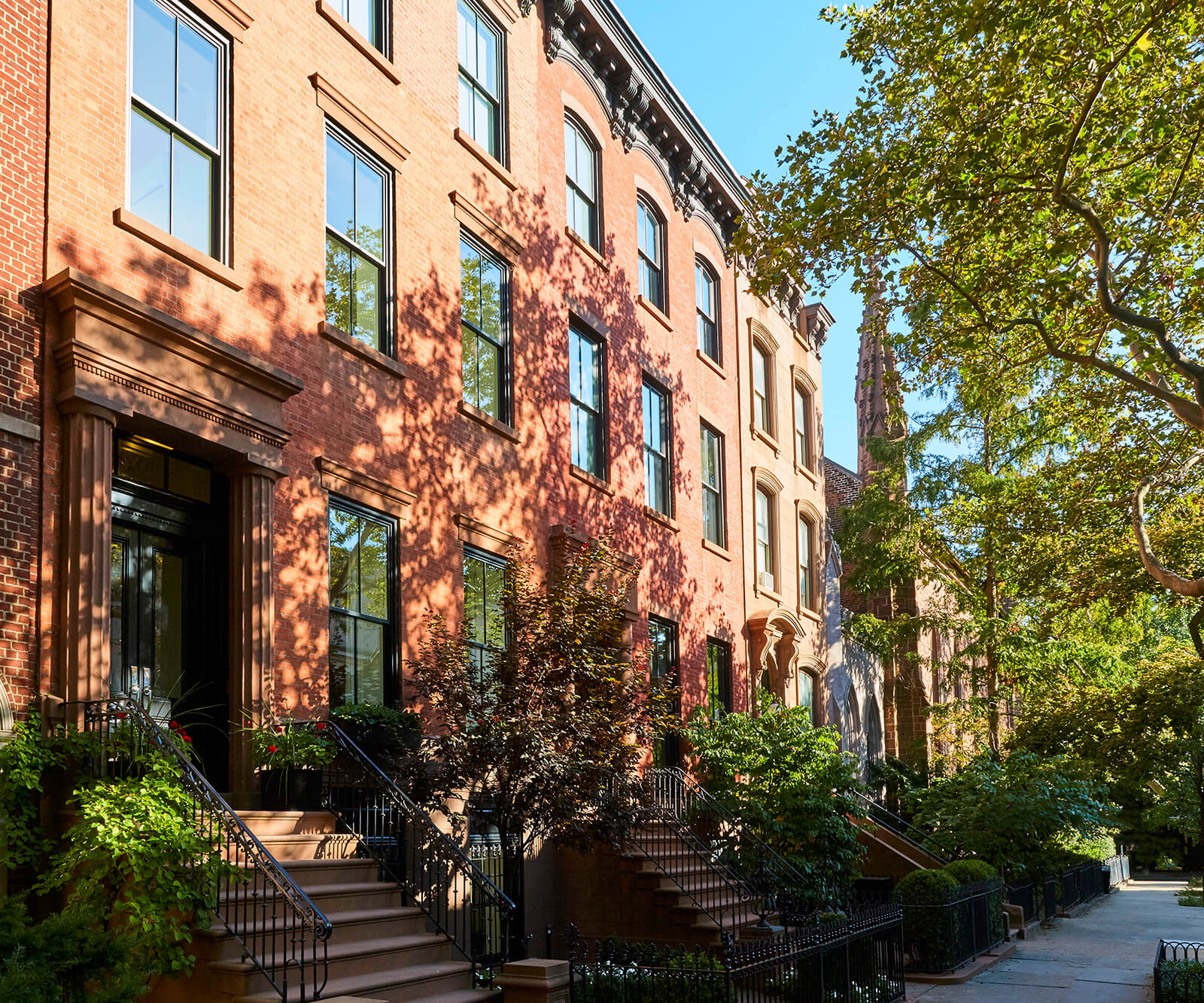
Eliza Jewett’s Years at 44 Monroe Place
The townhouse at 44 Monroe Place became home to the oldest sister, Eliza. She had married a man named John Garrett, who died soon after, leaving her a young widow of 30 with a daughter, Mary. She moved back home and remained at 44 Monroe Place for the rest of her life. When she died in 1901, at the age of 91, she had lived in the house for more than 70 years.
Eliza and Mary were certainly well off enough to live here without any financial difficulty. They lived here with family, including her sister Sarah, who lived here in 1880 with her husband William R. Sheldon, a banker, and their daughter Louise. Also in the home at that time were three servants, Mary Nolan, Ellen Dunnigan and Anna Harmon.

From time to time, they also had boarders. The Brooklyn Eagle shows ads for a room or two rooms for rent from the late 1880s through 1900. They wanted only single “gentlemen” for room and board. Most of Brooklyn Heights seemed to be taking in boarders of this type, and had been for generations. With the stock market and banking jobs just across the river on Wall Street, and the proximity to the Brooklyn Bridge or the ferries, this was an ideal place for a young, single man to rent.

Eliza’s daughter Mary died in 1899. She married John Bray Gardiner, a lawyer, and they had two children. Gardiner had died much earlier, in 1882. Mary was 67 when she died, after a long illness. Her funeral was here, at her mother’s house, the same house she had gotten married in, long before.
Eliza died of old age. Her obituary noted that up until a swift and final illness, she had been a fixture in the Brooklyn Heights community. She was active as the oldest member of nearby Holy Trinity Church. At her death, she lived here in the house with Washington Burton, a British-born salesman, and his wife, who was her granddaughter. Also in the home was a nurse, Kathie Striker, and Annie O’Toole and Mark Rork, the two servants.
Soon after Eliza’s death, her only surviving siblings, Charles and Lucy, as per their father’s will, put 44 Monroe Place up for sale. Charles was executor of the estate. A large ad ran in the Brooklyn Eagle in April of 1901. Charles would die in 1906, at the age of 76. Lucy died at her home at 111 Pierrepont Street, where she had lived for more than 30 years. She was 86, and died of old age, like her sister. She too was a local fixture, had her faculties to the end, was fond of taking long walks around the Heights, and loved shopping, visiting the Brooklyn Institute of Arts and Science and talking to young people.
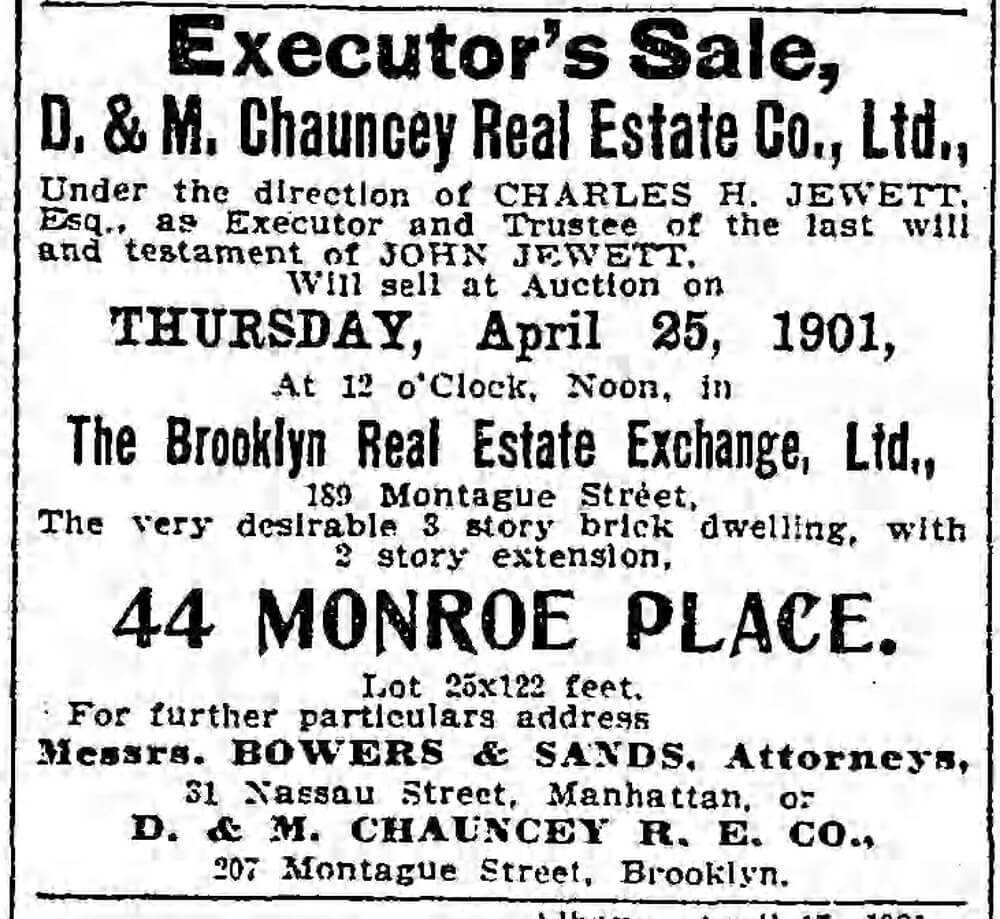
The Jewett house, after being in the family for 66 years, passed to the family of Dr. Caskie Harrison.

The Harrison Family
Caskie Harrison was born in Virginia, a distant relative of President Benjamin Harrison, and the grandson of John Caskie, who was head of the Tobacco Exchange when the Civil War started. He was a schoolboy when the war broke out, and slipped through the Union blockade on a ship that took him to England, where he was enrolled at Rugby, an elite private school.
He excelled in his classes and became the first American to become Head of House there. He was in the middle of his studies at Trinity College at Cambridge when the war ended and he decided to return home.
After finishing his education at Trinity College in Connecticut, he went on to get his PhD at the University of the South. Between 1872 and 1880, he was head professor of classics at that institution. In 1883, he moved to Brooklyn and established the Brooklyn Latin School for Boys at 185 Montague Street.

The school was private, small and selective. They taught classical languages, mathematics, and English literature as well as penmanship. The school conducted classes on the entire second floor of the building on Montague, which no longer stands. Only three years after opening, the school had 60 boys on its registry, including the sons of, as the paper said, “some of the best known people of the Heights.”
The school stressed individual attention to each student’s needs. By 1889, the school had a baseball team that played other private school teams in Prospect Park. A year later they established a baseball team. Brooklyn Polytechnic was a favorite rival.
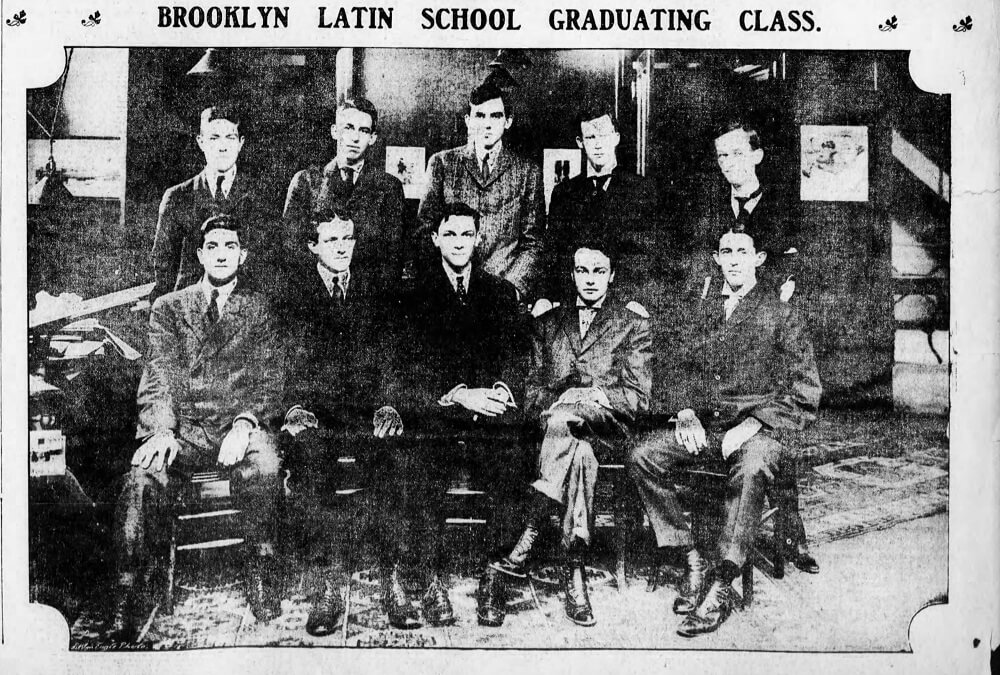
That year, the school moved to the Saltus House, at 145 Montague Street, where they occupied the entire building. They kept expanding, and by 1892 had nine teachers, including Dr. Harrison. By the end of the 19th century, the school had become one of Brooklyn’s leading private schools, with an impressive athletic program. Track and field, gymnastics, hockey and tennis had been added to their sports roster.
By 1900, the school had outgrown their home, and moved to 40-42 Monroe Place, just next door to Dr. Harrison’s home. According to the Brooklyn Eagle, this was a “massive four-story brownstone structure,” that met all of their needs. The article went on to say that the school was organized in the British fashion, with levels, and excelled in individual attention to all of its students.
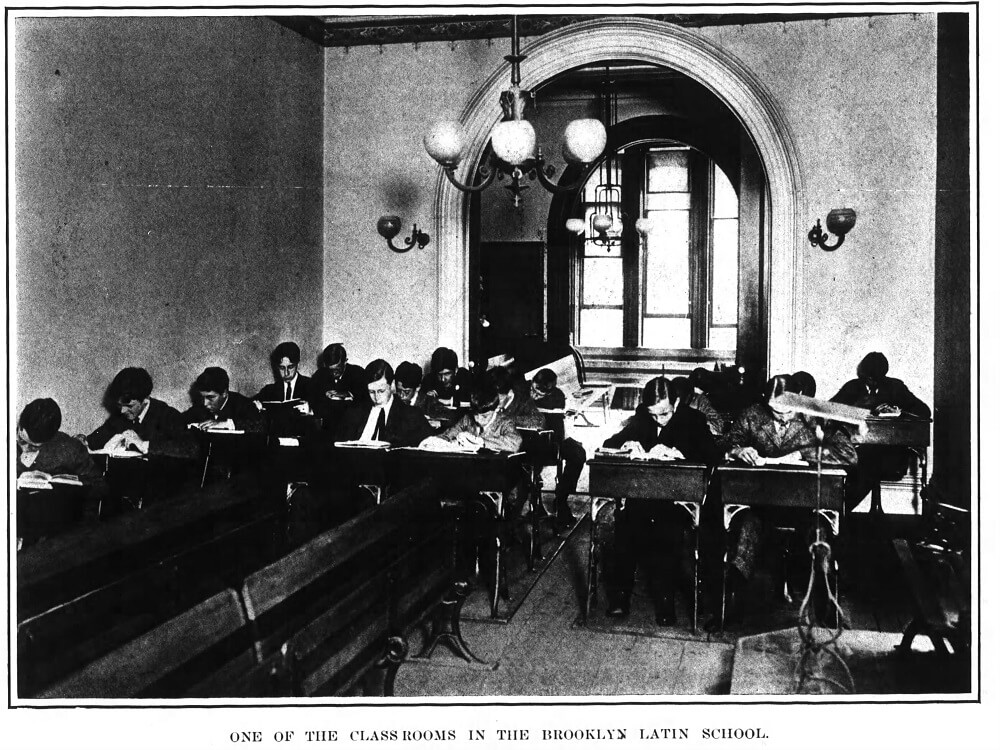
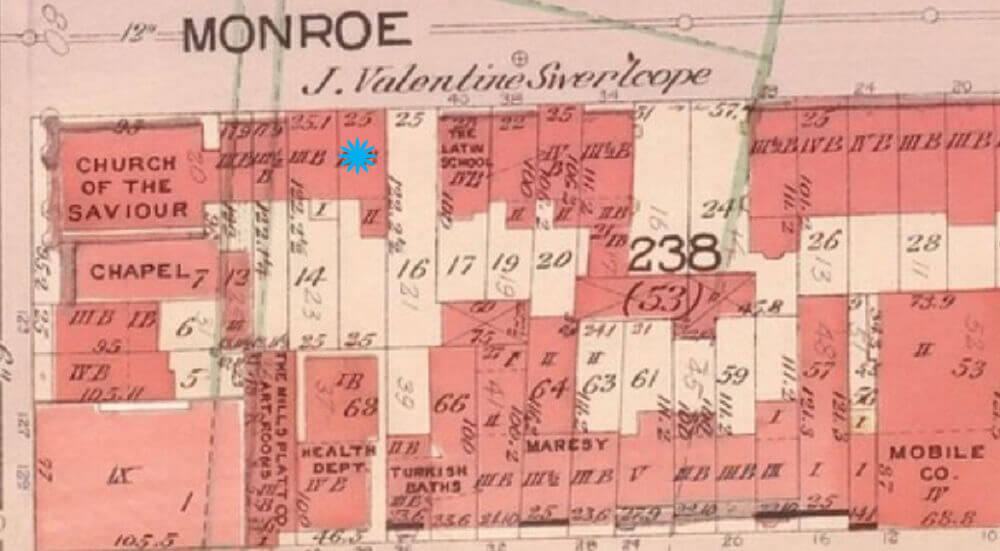
However, the school had only been on Monroe Place for about two years before Dr. Harrison died suddenly, at the age of 55. He and his wife had two sons and two daughters. One daughter, Margaret, was married here in the house to the Rev. Sanders Richardson Guignard in 1902, only months before her father died. The wedding, which was almost postponed because of his illness, was small and intimate. Sadly, Mrs. Guignard also died young, passing away three years later, in 1905.
One of her brothers, Henry Sydnor Harrison, was quite a young man about the Heights. It was thought that he would become a composer. Instead, he became a writer of novels and short stories. His most popular work, a novel called “Queed,” was a best seller. He died relatively young, as well, passing away at the age of 50 in 1930.
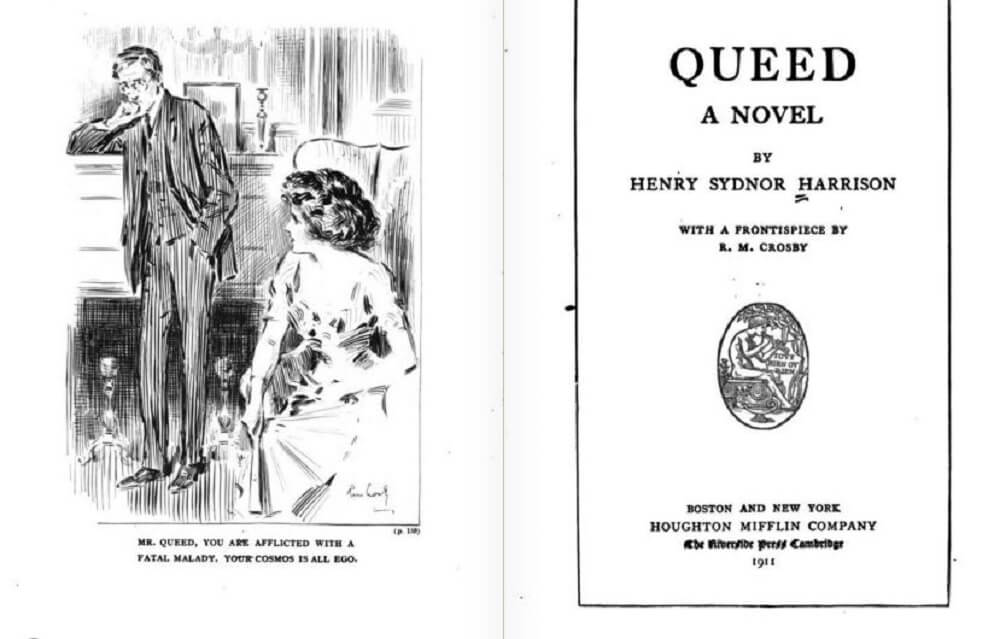
After Caskie Harrison’s death, his widow left Brooklyn in 1903 and returned to Richmond, Va., where they had once lived, and she had family. The house was ready for another owner.
As for the Brooklyn Latin School – it seems to have disbanded when the property was sold for development in 1913.
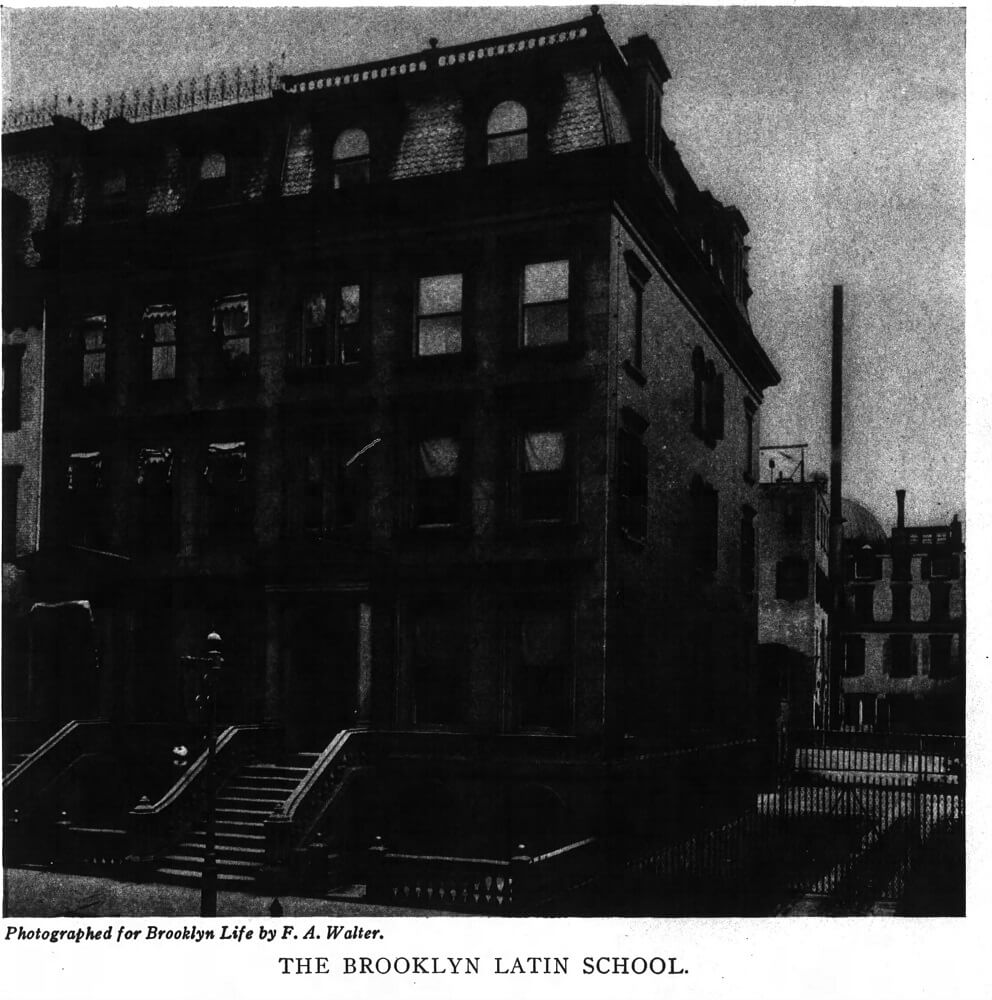
Short-Term Residents
That same year, the house was leased to the family of William Burger Boorum. He and his wife, Elizabeth, were originally from Englewood, N.J. They did not stay long and, according to the society papers, moved back to New Jersey a year later.
In 1904, 44 Monroe Place was rented by Maxwell Lester and family. They lived here from 1904 until 1913. Mrs. Lester’s family, the P. Augustus Hegemans, had been living across the street for many years, and the move meant a return to Brooklyn Heights for Norma Hegemans Lester.
Lester was listed as a salesman in the cement business. He was 34 years old in 1910, and his wife was 30. They had two children, Maxwell and Edna, and two live-in servants in the house. Edna was born here at home in 1907.
The Lesters left in 1913, and 44 Monroe Place was leased yet again. The next resident was Otto Kempner and family. Otto Kempner and his wife Sarah had three children. When they moved to 44 Monroe Place, Kempner was already the Chief Magistrate of the Second Division of the City of New York. Sarah Kempner was well known in charitable circles as the President of the Counsel of Jewish Women. They were members of Temple Israel, one of Brooklyn’s most influential synagogues. Kempner was a Trustee, as well.
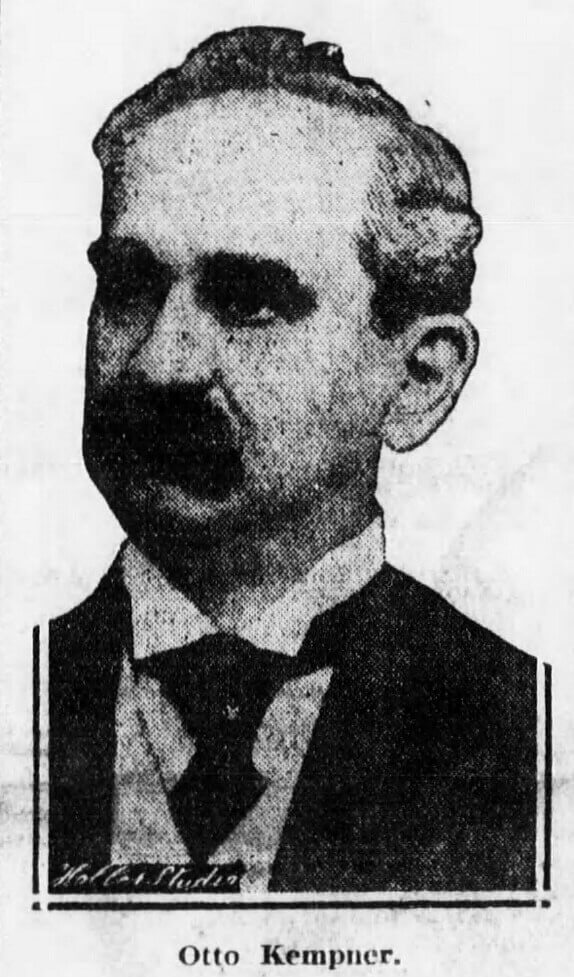
Otto Kempner had been born in Austria. He came to America with his family at the age of 11. He took classes at Cooper Union and became a teacher. He got a job teaching English at a German school on the Lower East Side. He was so good at the job, three years later, he was the principal.
While teaching, he took classes at New York Law School at night, and passed the bar in 1884. He went into politics and became an Assemblyman for his district in Albany. He became well-known as an opponent of the Democratic bosses of Tammany Hall.
Tammany vowed to end Kempner’s political career, but they could only stall it. As a Brooklyn resident, he fought with other Brooklyn Democrats who were opposed to Manhattan’s Tammany influence. He even wrote a pamphlet called “Boss Croker’s Career,” chronicling the rise of Richard Croker, the turn of the 20th century Tammany Boss. The piece made Otto Kempner quite famous in New York. Very few people crossed Croker and continued to succeed.
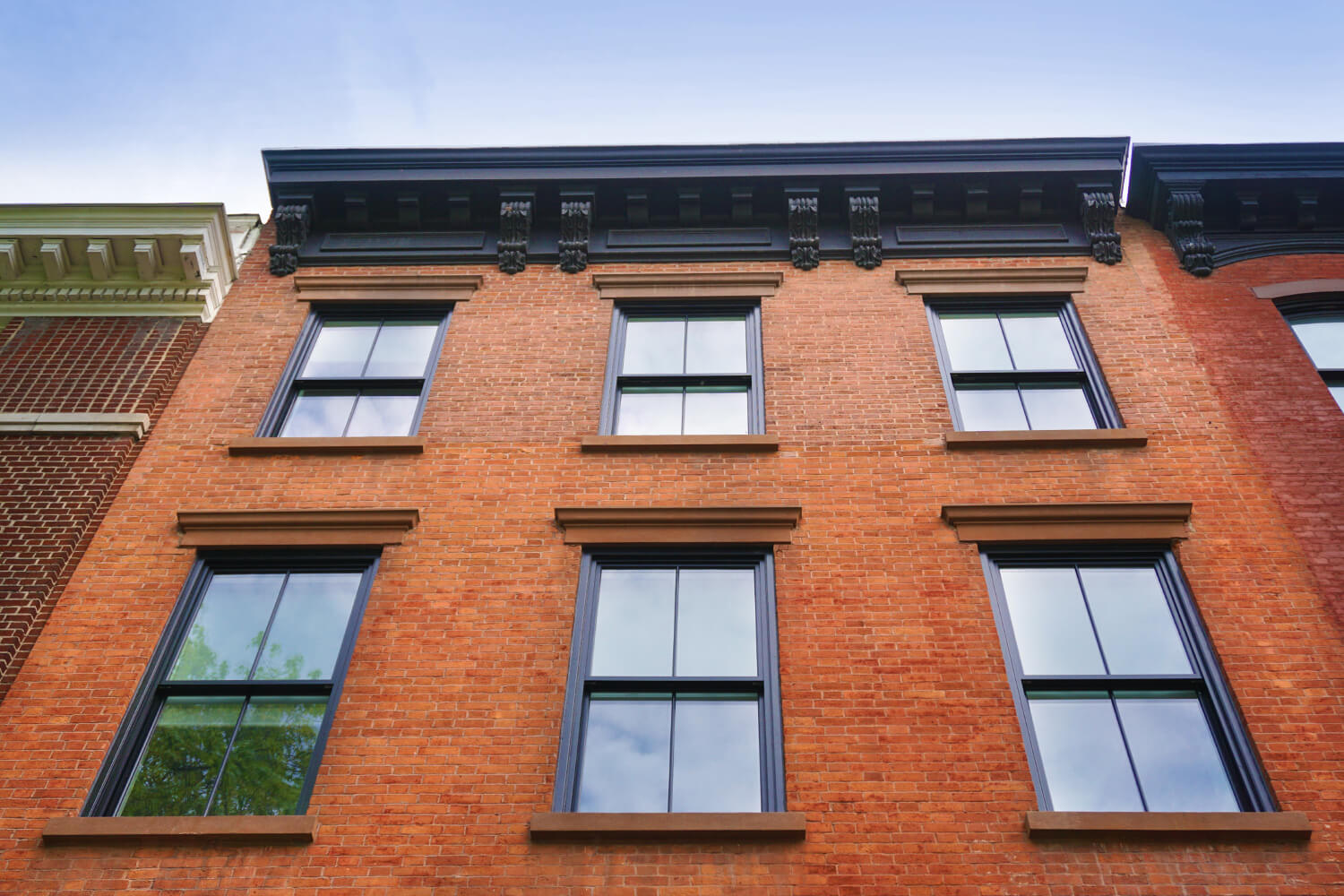
He worked with “Fusion” candidate and Brooklyn Heights’ favorite son, Seth Low, in his run for mayor of New York, and was a friend of both reform Republicans and Democrats. When William J. Gaynor became mayor after Low, in 1910, Kempner was appointed Chief Magistrate of the Second Division, which covered Brooklyn, Queens and Staten Island.
As a judge, Otto Kempner was known to be fair to both his staff, as well as first offenders. He was on record saying that everyone deserved a second chance. He was well-known for his charitable work from the bench, as well as with the many clubs and organizations he belonged to.
The family was only in the house for a couple of years before Magistrate Kempner was diagnosed with cancer of the mouth. He was treated by the best cancer doctors of the day, but the disease kept coming back. He had several operations and a stay at a sanitarium outside of New York, but to no avail. Otto Kempner died on October 8, 1914.
The Kempners had lived at 44 Monroe Place with their daughter and son-in-law, Alma and Israel Kleiner. They stayed in the house with her mother until they moved on in 1918 or ’19. Israel Kleiner was one of many Americans almost trapped in Paris at the beginning of World War I. He had been there on business. He told his story to the Brooklyn Eagle on his return, giving evidence to the growing fear and disbelief that war was coming to Europe.
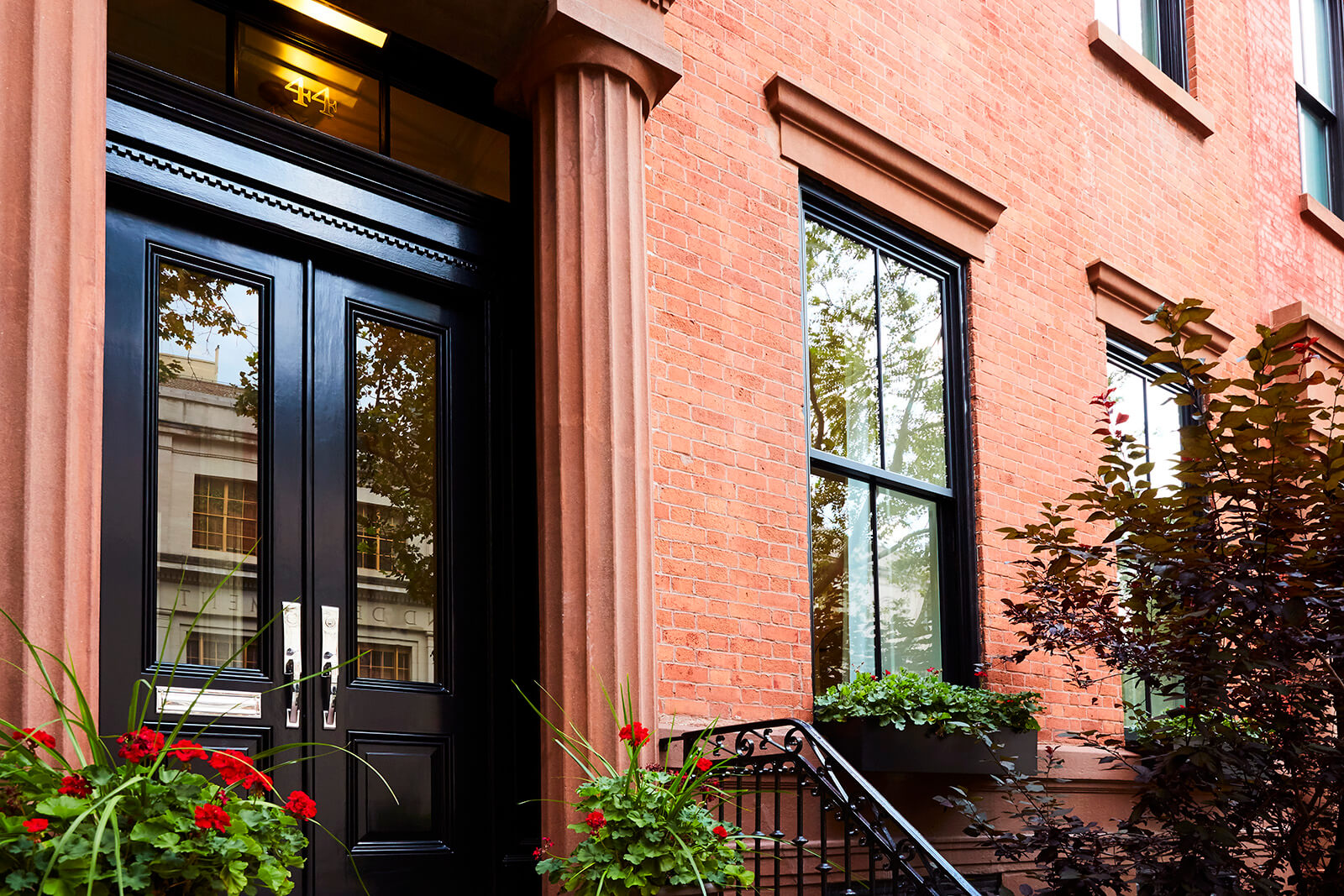
The Colket Family
The last family to make a long-term impression at 44 Monroe Place was the Colket family. James and Ethel Colket moved here in 1919. Like all of the occupants of this townhouse since the Jewetts, they were renters. They lived here with their three children and two servants. Children Elizabeth and James were teenagers, and young Earl was three years old.
The Colkets were originally from Philadelphia, and came to New York in 1905. James Hamilton Colket was an electrical engineer with the New York Telephone Company. He worked for the phone company for 35 years, before retiring in 1932.
The family was Quaker, and was active in Brooklyn’s Friends community. Their daughter Elizabeth was married to Harold Lincoln Wilson of Philadelphia here in the house in 1927. The Brooklyn society pages noted that the wedding was simple, as per Quaker custom.
The Colkets lived here from 1919 until at least 1941, when James Colket died, after a long illness. He was 66 years old. They lived here for at least 22 years.
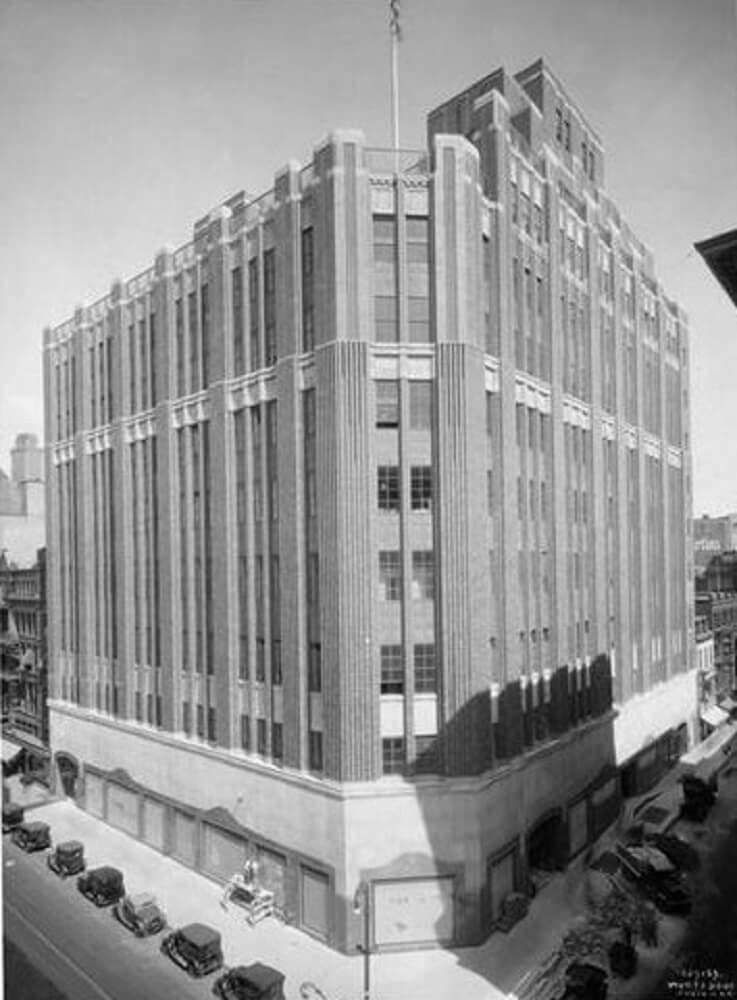
Robert Edward Blum and Family
By 1946, the home had been leased to the Robert Edward Blum family. He and his wife Ethel announced the coming out of their debutante daughter Alice Elizabeth Packard Blum in 1946. They didn’t stay here long, but the Blums were incredibly important to Brooklyn’s cultural life.
Robert Blum was a son of Brooklyn, born in 1899. He was the grandson of Abraham Abraham, one of the founders of Abraham & Straus, Brooklyn’s most important department store. He graduated from Yale in 1921 and joined Abraham & Straus. He retired in 1946 as a vice president and secretary. He had also been a director and vice president of Federated Stores, which owned Abraham & Straus. He held these offices between 1944 and 1965.
After retiring, Mr. Blum turned his attention to New York City’s cultural life. He was instrumental in the early development of Lincoln Center, and was treasurer from 1956 to 1963. He was a director emeritus after 1969.
He also was elected an honorary trustee of the Museum of Natural History in 1970, and was a trustee of the Brooklyn Museum and a member of its advisory board until his death. He was also associated with the Brooklyn Children’s Museum, the Brooklyn Public Library, the Brooklyn Botanic Garden and the Brooklyn Academy of Music, not to mention several other Manhattan cultural institutions.
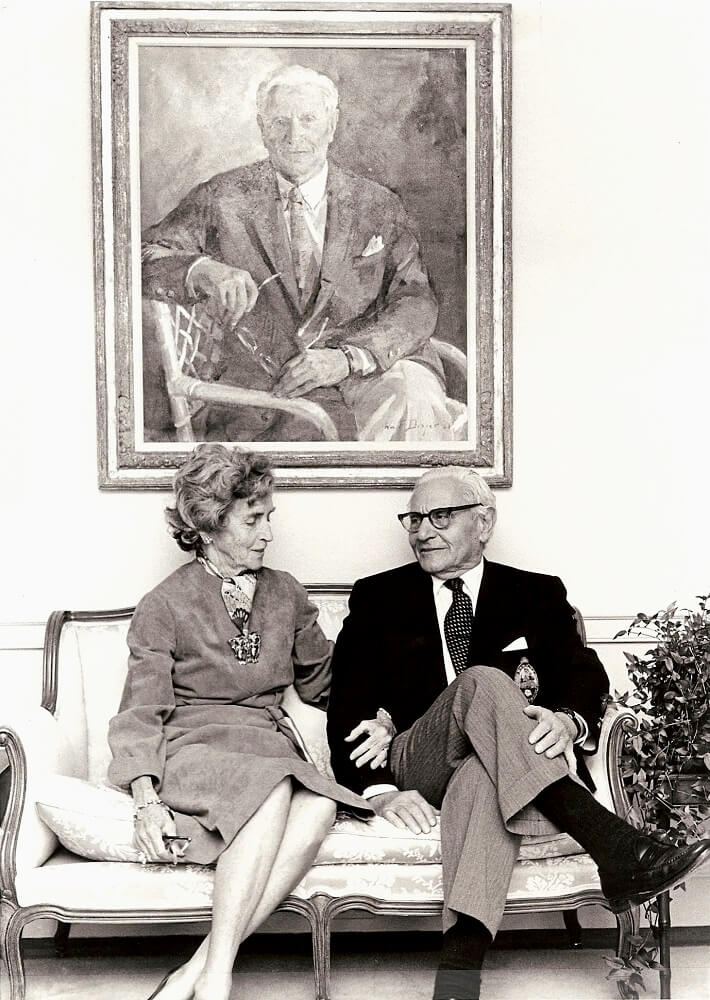
Robert Blum died in 1999 at the ripe old age of 100. His wife of 67 years, Ethel, died in 1991. The Blum family moved from Brooklyn years before. Both Mr. and Mrs. Blum and their two married children lived in Lakewood, N.J. When Robert died, he left behind his children, nine grandchildren, and 19 great-grandchildren.
44 Monroe Place has had a tremendous history over the past 181 years. Recently this historic home has been meticulously renovated for luxurious 21st century living. The stage is now set for new owners to move in and write the next chapter of this great Brooklyn townhouse story.
For more information or to arrange a private showing of 44 Monroe Place, please contact Associate Real Estate Broker Paul Murphy of Corcoran.
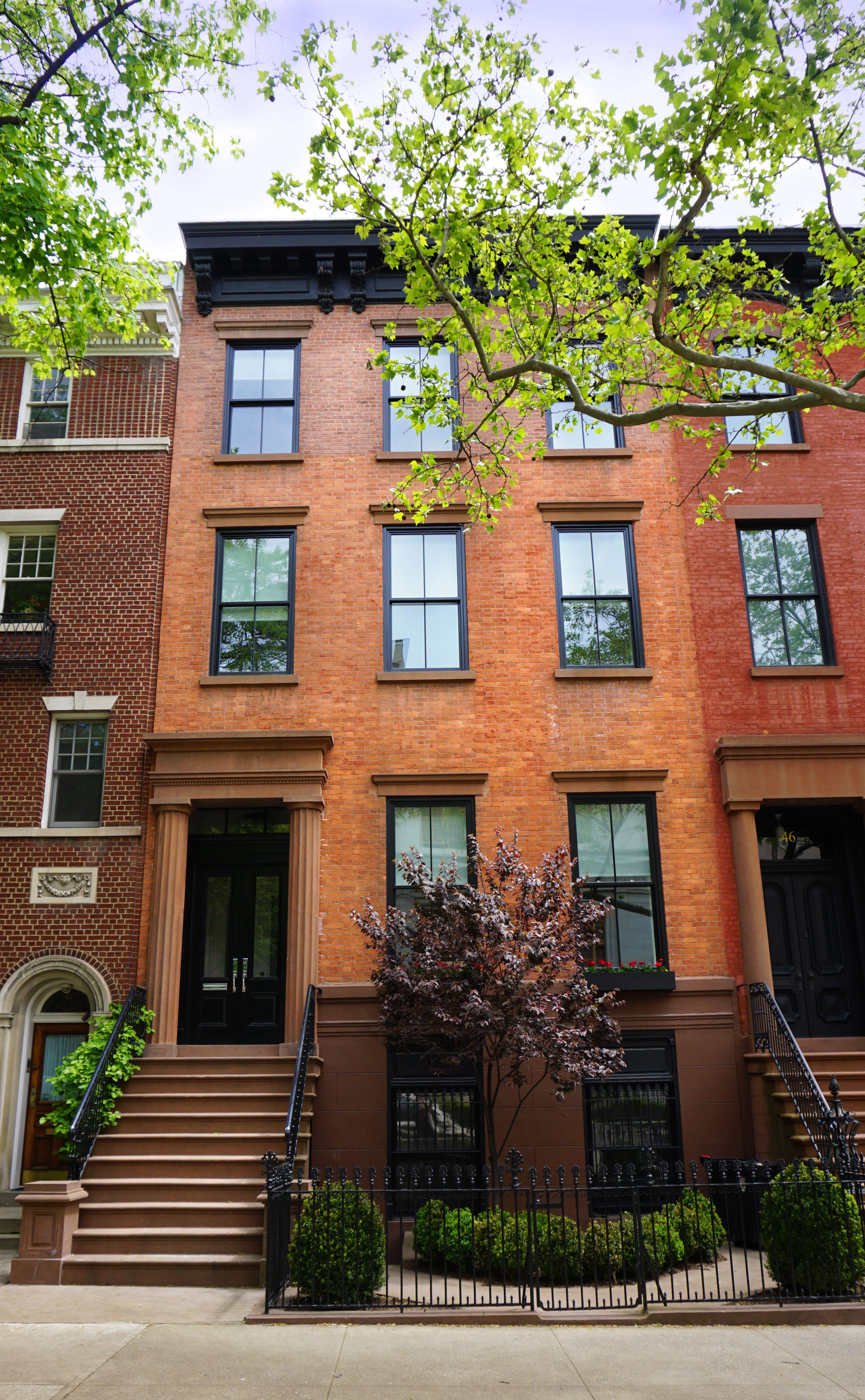




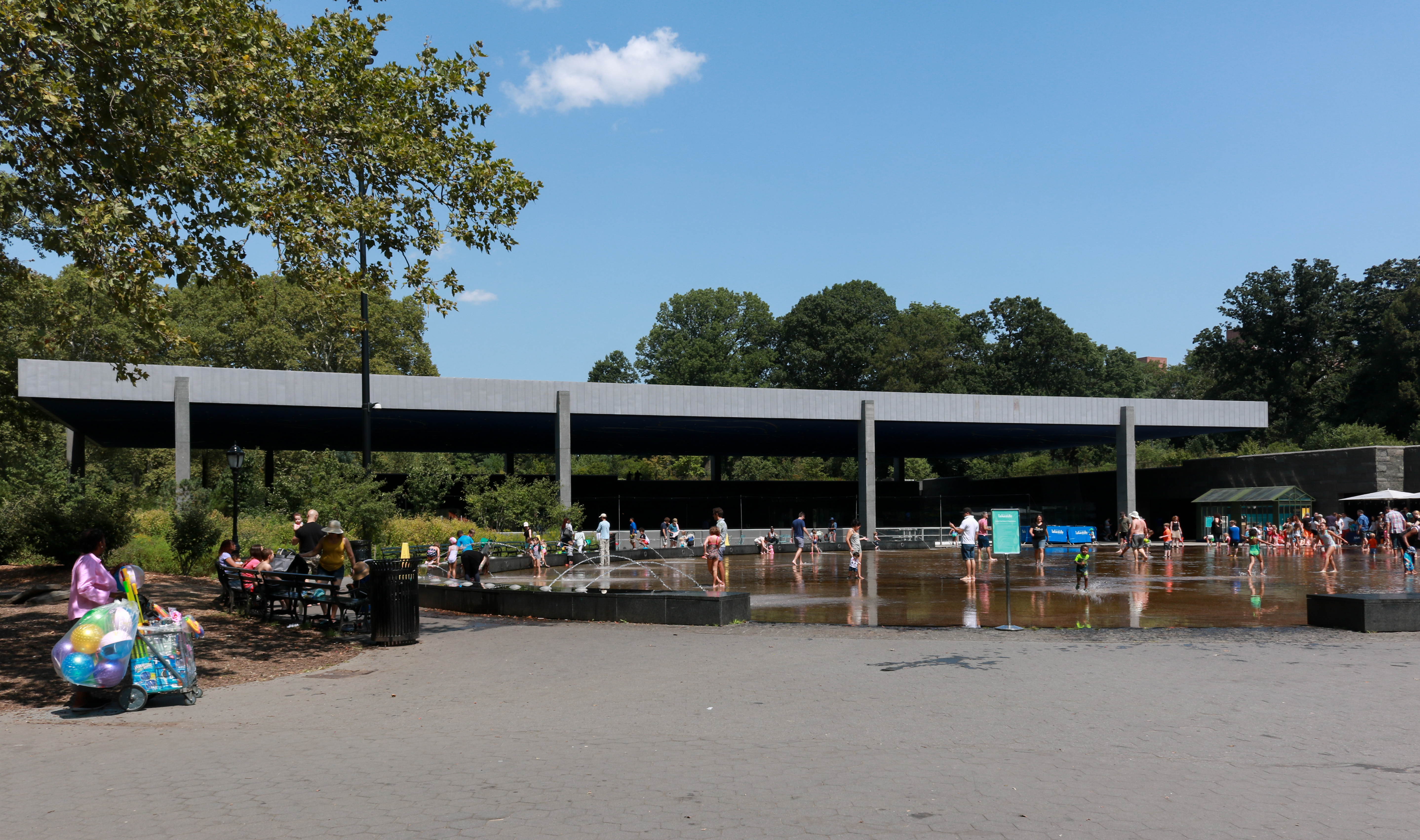
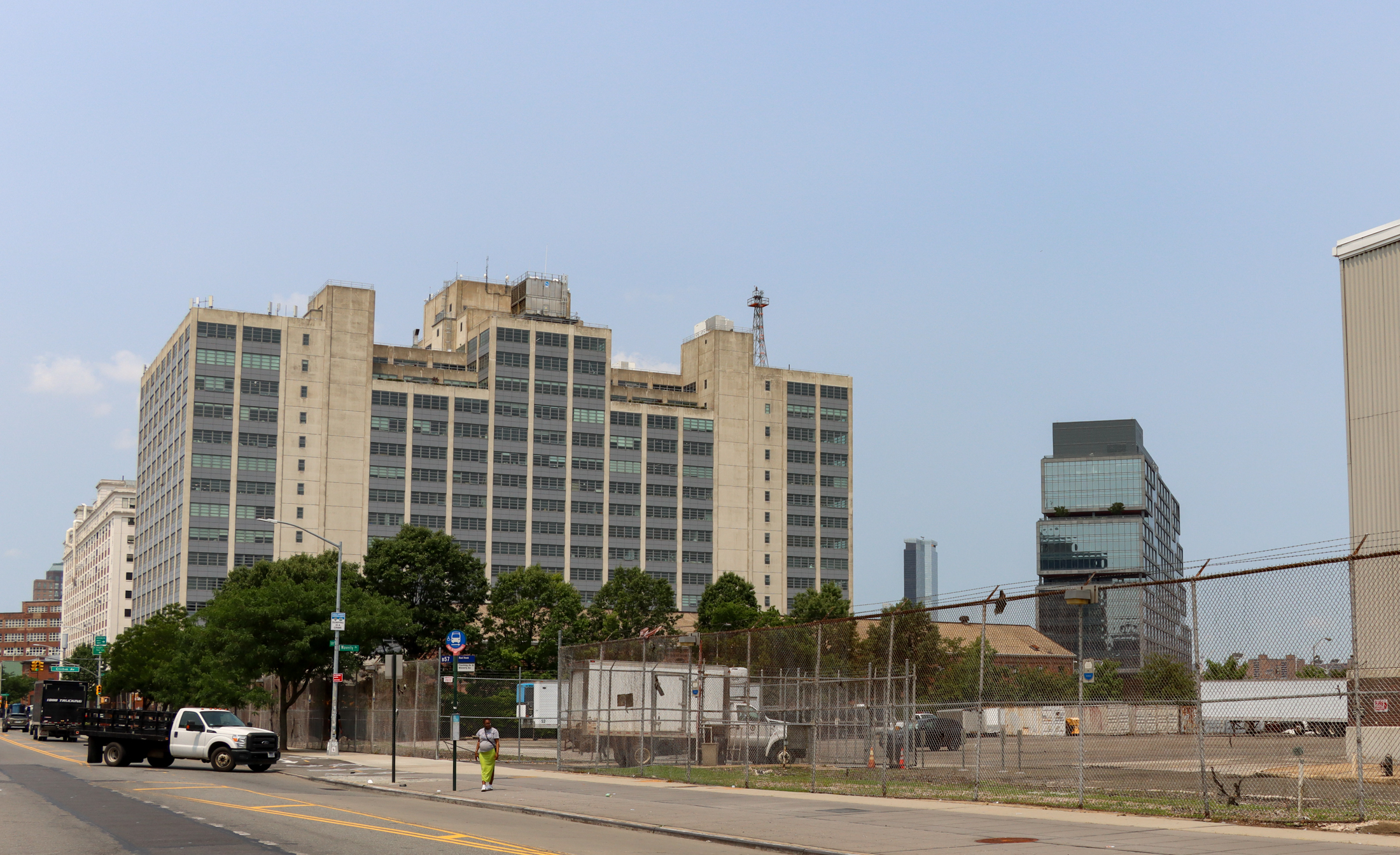
What's Your Take? Leave a Comment